What is a Sales Cycle: Definition, Stages, and Steps
Every sales success is a successful customer journey. The goal is to master attracting the perfect customers and close deals.
You can understand and improve your sales repeatedly from the last. But this can only happen through a seven-step process, and you may need to pay attention to it.
What is a Sales Cycle?
Potential leads go through buying stages when considering their needs and what business to buy from.
A sales cycle is a company's step-by-step process to sell its products or services to a prospective customer. This cycle involves identifying potential customers, engaging with them, making a pitch, handling objections, closing the deal, and providing follow-up support.
Sales and marketing teams go through this sales cycle successfully by using well-defined processes. They align sales strategies with marketing efforts to improve sales and close deals.
The kind of industry, buyer behavior, and product type are the reasons why most sales cycles are different. Sales cycles are a great way to nurture lasting relationships.
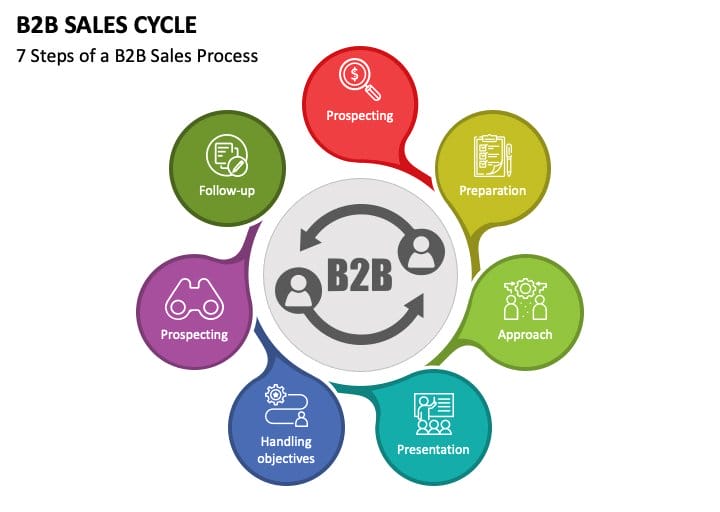
Importance of Managing Your Sales Cycle
Sales cycle management is critical because potential customers need to know they are in safe hands when they are about to buy from you. Most sales cycles start when people become aware of the business and end when they decide to buy.
Good sales cycle management will result in the following:
1. Increase in Sales
The first way to improve sales is through a well-managed sales cycle. How does it happen? An increase in sales occurs when your sales rep responsible for handling the sales process can achieve desired results through constant practice.
The more effective the sales reps are with the sales process, the more improved the sales reps' productivity will be. Track the average sales cycle length for every sales rep and work on lowering it to generate more sales.
Every team member's drive for the sales process will automatically increase their ability to close deals successfully with better-paying customers.
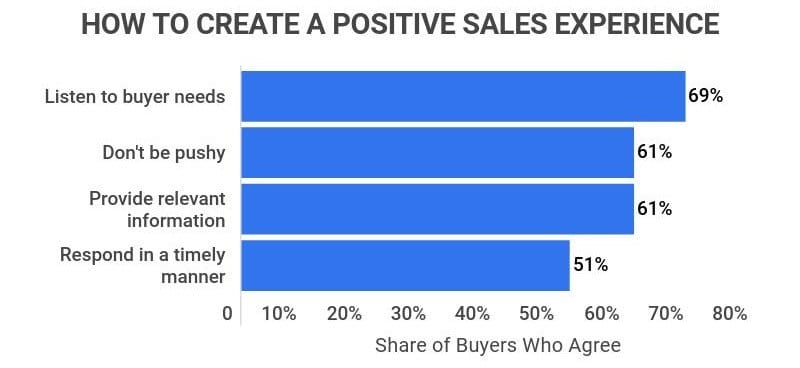
2. Efficient Lead Generation
A well-managed sales cycle makes it easy to have an efficient lead-generation process that would bring the right people to your business early on.
Effective lead generation will always happen when team members collaborate to create a new sales process. The process outcome will yield repeated business success. Connect with the right people, not just anyone, to maintain a continuous cash flow.

3. Customer-Centric Services
In managing your sales cycle, you can put yourself in your potential customer's shoes to find the best approach to get them to buy.
Understanding the buyer's journey and pain points will earn you their trust and loyalty because you have chosen to be customer-centric in your services.
If you are only concerned about making money rather than satisfying your customer needs, you will have fewer loyal and returning customers.

4. Good Decision Making
Decision-making happens when you frequently do a review and carry out an analysis of a project you are currently managing.
Evaluating Key Performance Indicators (KPIs) in the sales cycle provides valuable insights. This process helps in making informed decisions and executing projects with better precision.
With this process out of the drawing board and in play, you can guarantee that every decision will yield the desired result.

5. Customer Satisfaction
A well-managed sales cycle will produce more satisfied customers who will remain loyal and recommend them to others.
Satisfied customers are well-paying customers. A well-managed sales cycle creates a shorter and faster buying process.
Smart business owners and sales reps create flexible sales cycles that cater to best convert the different types of customers that enter their sales funnel.
6. Strategic Planning
Strategic planning is crucial for managing your sales cycle. There are stages where your sales cycle may need to be stronger. Strategic planning will help you identify and target your training for a weak point.
7. Defined Goals
A defined sales cycle process will show new staff your business's short-term and long-term goals at every stage. Managing your sales cycle will ensure your different business objectives and goals are in check and easily identifiable by all team members.
7 Stages of the Sales Cycle
A standard sales cycle has seven stages. These sales stages are tested and proven to make the sales cycle essential and successful.
1. Prospecting
Sales prospecting is like scanning a playground for potential playmates, choosing who fits the standard, and understanding how various games work.
Prospecting is a technique used for people who may have an interest in what your business has to offer.
Market research helps to understand which customer profiles are the best fit. Smart sales reps target people who have some form of interest in their products or services.
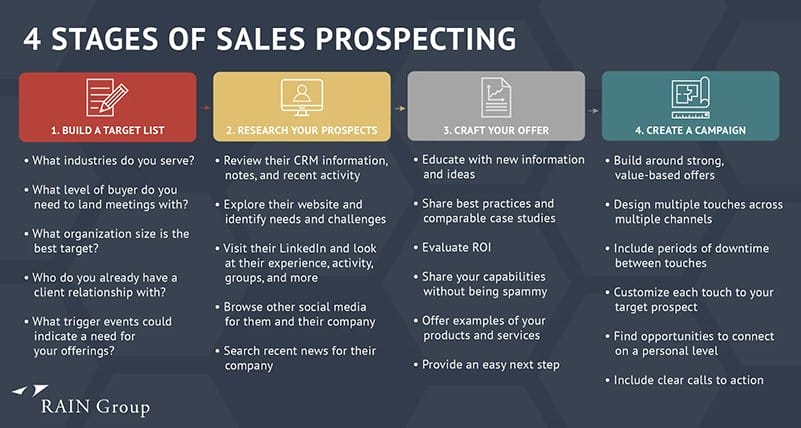
If you want to enjoy successful sales prospecting, there are some quality tips you can follow.
- Identify Your Potential Customers: You can only identify potential customers by first understanding your product or service. Define the group or customer profile that benefits most from what you offer. Picture your ideal customers – who are they, what they need, and where can you find them?
- Conduct Surveys or Interviews: Use surveys to gather insights from existing customers. Analyze demographics like age, location, and income. Explore website analytics tools to track visitors. Social media platforms offer valuable data on user interests.
- Make Informed Decisions: Use your existing customer data to analyze trends that worked well in the past. Consider various perspectives and explore the pros and cons of each option. If they seem complex, break down the information into manageable parts. Be open-minded and adaptable, willing to adjust your decisions based on new insights.
- Network with Like-minded People: Form strategic partnerships with businesses that share your target audience. Use social media to connect with individuals who have shared passions.
- Follow Trends: Continuous learning is critical. Educate yourself on evolving market demands. Regularly explore popular platforms, read news, and engage in conversations within your community. Pay attention to emerging technologies and industries, so you don't miss out on potential customers.
2. Qualifying Leads
Qualifying leads involves finding the right people who want what you are offering. Only some potential customers end up as paying customers. Qualifying leads saves you from wasting time and resources trying to convince customers with little or no interest in your product.
Imagine you are selling yummy ice cream. You would not try to sell it to someone allergic to dairy products. Instead, you will figure out those who love ice cream and are currently interested.
Offering ice cream to someone looking for a hotdog is a bad idea. Even if you convince a few to buy, the time and effort will produce little results.
Now, if you qualify your leads to those who are actively interested and have the purchasing power, you will enjoy better results.
Qualifying leads is more than convincing everyone to buy from you; it is about finding the most likely to buy.
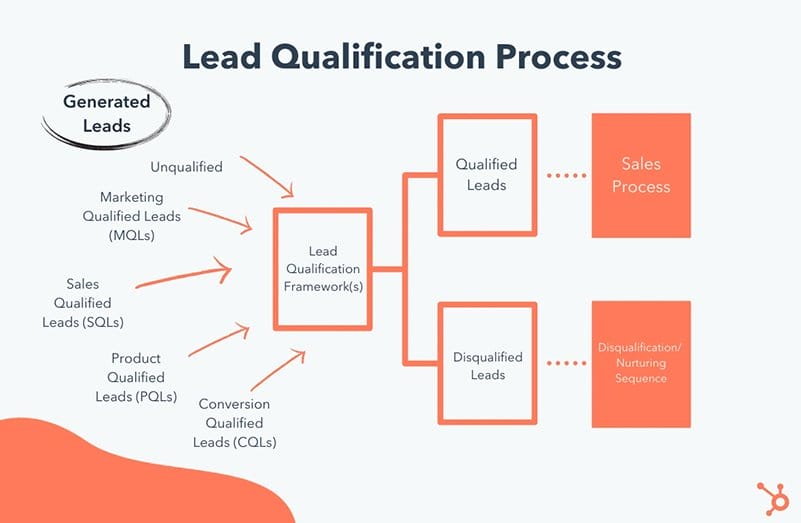
3. Initiating Contact
After qualifying leads and discovering how many prospects are ideal for your business, you have to initiate contact. You can dig up information from your target customer profiles to understand your potential clients and the ideal approach.
Certain factors will influence your communication channels, approach, and sales pitch when in contact with qualified leads. Your objective is to make a genuine and lasting connection with leads.
Consider the business type and the most effective communication strategy to give qualified leads a pleasant experience and a taste of your value proposition. Understanding how your potential customer thinks will come in handy.
The best strategies may include phone calls, in-person meetings, discovery calls, emails, physical letters, and video conferencing. You must keep the best part of your sales pitch for the latter and keep all your cards private at this stage.
The purpose of this phase in the sales cycle steps is to create a connection with potential customers.
4. Presentation
Sales presentation is where you showcase your product or service to the world, but most importantly, to your potential customers.
You are in a room with knowledge about your potential customer's pain points and the perfect solution – your product or services. Your goal is to make them go, “Wow, this is exactly what I need!”
Sales presentation is a vital part of the sales cycle because it gives you a shot at a potential customer and repeat future sales.
How to Nail the Presentation
- Understand your Audience: You need to know who you are presenting to. Are they looking for a robust, quick, or long-term solution? Use market research, surveys, or client interactions to gather insights. You create a connection that resonates by aligning your message with their expectations.
- Be Clear: Could you keep it simple, clear, and exciting? Carefully highlight how your product or service can save the day – or at least improve it! Paint a picture of scenarios where customers seamlessly integrate your products, experiencing moments of delight and satisfaction.
- Use Visuals: Use pictures and graphs to back up your claims. A compelling image or graph can make complex information easy and more accessible to your target audience.
- Use Social Proof: Do you have satisfied customers? Share their stories. Social proof is an extra point in this sales cycle. This extra layer of authenticity can significantly impact the decision-making process in the sales cycle. Remember, a picture is worth a thousand words, and genuine stories speak volumes.
- Be Ready for Questions or Concerns: If someone says, “But what about this?” or “I'm not sure,” address their concerns confidently. Become familiar with industry trends and competitors to address comparative questions. Maintain a positive attitude, be open to feedback, and view questions as opportunities to showcase your commitment.
- Add a Call-to-Action: Leave the customers with what to do after your presentation in this sales cycle. Use persuasive language and mention the benefits they will gain. Create a sense of urgency, like a limited-time offer or exclusive deal. Make the offer irresistible. Keep it simple and direct so that they can understand the immediate value of taking action.
5. Handling Objections
This sales cycle stage is the most tasking and overwhelming because the outcome will determine if you will successfully convert a generated lead to a paying customer.
After being acquainted with your product or service, potential customers will likely have specific objections or may face issues while exploring. You are usually the next point of contact, and they may come for your head.
Ensure you maintain your composure and put out every fire they highlight during this phase to ensure you keep them interested. If you successfully manage this phase by debunking every objection and reassuring the customer, closing the sale will be seamless.
You cannot separate a perfect sales process from a faultless execution of this phase and a smooth running of the sales life cycle. Hire qualified individuals as customer service reps to handle objections from customers or use virtual assistant tools.
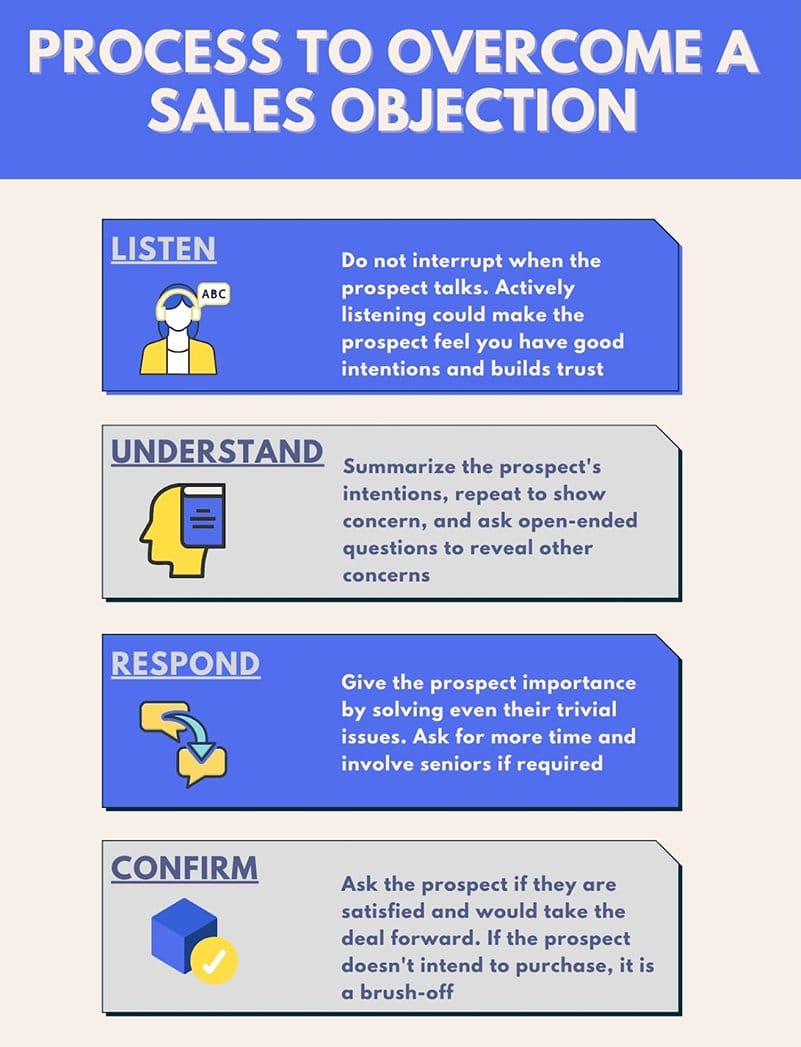
6. Closing Deals
From the first stage of the sales cycle, closing deals are the moments every sales rep is looking forward to. Closing deals is like reaching the finish line in a race, where everything you have dreamed of and all your efforts become a reality.
Even at this sales cycle stage, the job still needs to be completed. Ask the right questions, listen actively, and address any remaining hesitations.
One key element in closing deals is creating a sense of urgency. Just like a limited-time offer saying, “This product won't be available for long!”
Your potential customers will be motivated to decide, knowing they might miss out on something valuable if they miss your offers.
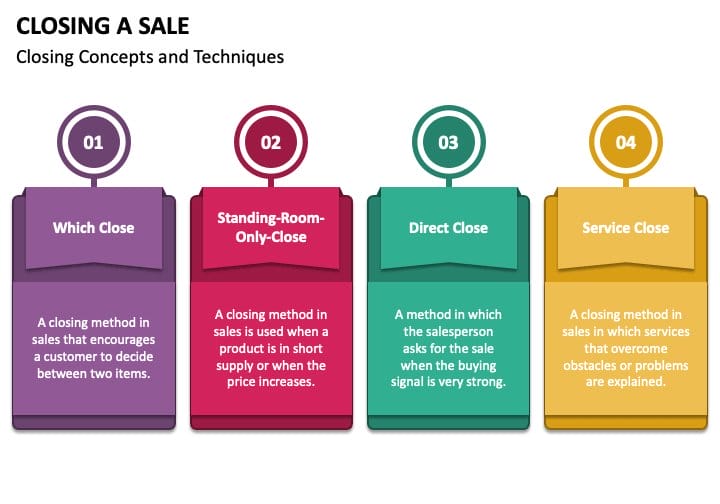
7. Follow-Up
Friends remember each other. After every excellent adventure together, they keep in touch to know how they are faring.
Follow-up shows that you care enough about the customer and not just after their money. You may not get a quick response once you have planted the seed of interest, but follow-up will help you nurture the desire.
Only some people make a decision right away. Life gets busy, choices pile up, and sometimes, a gentle reminder is all it takes to get a purchase.

Why Follow-Up Matters
- Projects Customer-Centrism: Your potential customers might be juggling various options, considering budgets, or waiting for the right moment. Here is where your friendly follow-up steps in. Follow-up shows you care, value their time, and are ready to assist.
- Reduces Waiting Time: Have you ever played the waiting game? It is not a good situation to be in. Your potential customers might appreciate a push in the right direction. The follow-up is not just a reminder; it is an opportunity to highlight why choosing you is the best decision. Still, make use of your social proof.
Best Practices for Creating Your Sales Process
Creating an effective sales process is crucial for turning potential customers into satisfied buyers. You may already have an existing sales process but can improve it.
Prioritize continuous improvement in three critical areas to avoid a long sales cycle for your business.
1. Use A Customer-Centric Approach
Your customers are vital to the success of your long or short sales cycle. How you handle them will determine how successful the sales process will be. By focusing on the well-being of your potential customers, you can guarantee loyalty and repeat purchases.
Your goal is to identify their needs or pain points and craft your product or service to meet these needs. If your potential customer discovers that you have them in focus, you will seamlessly get them moving through the sales process.

2. Social Proof is Your Trump Card
Consider the importance of social proof when creating a foolproof sales process. No one wants to buy a product that has no previous purchase history or has negative feedback from initial consumers.
Your goal here is to use the positive feedback you got from your initial customer to influence potential customers' opinions and purchase decisions.
Consistently uploading social proof content ensures prospects see your offering positively and are willing to pay top dollar.

3. Align Sales with Your Marketing Team
The worst mistake you can make when creating your sales cycle is to make promises your product cannot fulfill. This mistake can cost you your credibility in the eyes of your partners and prospects, leading to bad reviews and negative publicity.
Getting your sales and marketing team to work hand-in-hand is crucial for running a successful sales cycle. With the right strategies, both teams will have their thoughts and opinions in sync and ready to woo prospects.
Have Your Sales Team Manage The Sales Cycle Stages
From the initial prospecting phone call to closing deals, every move matters. Your sales team should be able to handle the 7 basic sales cycle stages whether you are present or not.
Some small businesses may not have an exceptional sales team, but they can achieve so much if every person works towards the sales process together.
As your sales team masters the art of sales cycle management properly, they improve sales, hit sales process KPIs, and achieve perfect harmony.
Empower your sales managers and sales reps to close deals, improve your sales cycle, and create a memorable experience for new customers.
With the proper steps and Customer Relationship Management (CRM) tools, your sales team can make every stage of the sales cycle easy.
You won't struggle with lead generation or repeat customers because your sales and marketing team has a well-defined sales cycle to work with.
Explore Further
- What Is a Sales Funnel?
- Motivational Sales Quotes
- Types of Customers
- Most Highly-Rated Sales Books
- Types Of Consumer Buying Behavior
- The Ultimate List of Cold Calling Statistics
- Tips on Selling Software
- Best Sales Pipeline Software
- Best Sales CRM Software
- What is Sales Force Automation?